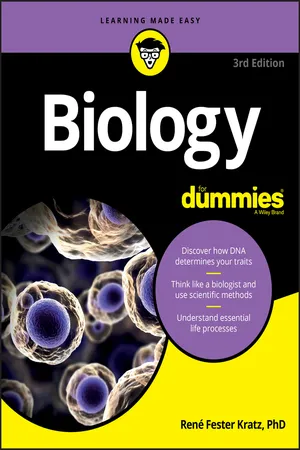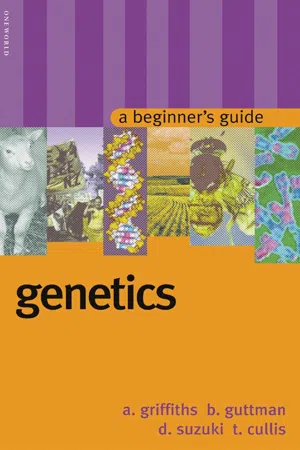Biological Sciences
Comparison of Mitosis and Meiosis
Mitosis and meiosis are both processes of cell division, but they have distinct differences. Mitosis results in two identical daughter cells, while meiosis produces four genetically diverse daughter cells. Mitosis is involved in growth, repair, and asexual reproduction, while meiosis is specific to sexual reproduction and leads to genetic variation.
Written by Perlego with AI-assistance
Related key terms
4 Key excerpts on "Comparison of Mitosis and Meiosis"
- eBook - ePub
- Rene Fester Kratz(Author)
- 2017(Publication Date)
- For Dummies(Publisher)
eggs.Mitosis and meiosis have many similarities, but the differences are essential. We cover both processes (as well as the interphase) in the sections that follow, but Table 6-1 can help you sort out the important differences at a glance.TABLE 6-1 A Comparison of Mitosis & MeiosisMitosisMeiosisOne division is all that’s necessary to complete the process. Two separate divisions are necessary to complete the process. Chromosomes don’t get together in pairs. Homologous chromosomes must synapse to complete the process, which occurs in prophase I. Homologous chromosomes don’t cross over. Crossing-over is an important part of meiosis and one that leads to genetic variation. Sister chromatids separate in anaphase. Sister chromatids separate only in anaphase II, not anaphase I. (Homologous chromosomes separate in anaphase I.) Daughter cells have the same number of chromosomes as their parent cells, meaning they’re diploid. Daughter cells have half the number of chromosomes as their parent cells, meaning they’re haploid. Daughter cells have genetic information that’s identical to that of their parent cells. Daughter cells are genetically different from their parent cells. The function of mitosis is asexual reproduction in some organisms. In many organisms, mitosis functions as a means of growth, replacement of dead cells, and damage repair. Meiosis creates gametes or spores, the first step in the reproductive process for sexually reproducing organisms, including plants and animals. Interphase: Getting organized
During interphase, cells engage in the metabolic functions that make them unique. For instance, nerve cells send signals, glandular cells secrete hormones, and muscle cells contract. If cells get a signal to reproduce, they grow, copy all of their structures and molecules, and make the structures they need to help cell division proceed in an organized fashion (inter - means “between,” so interphase - eBook - ePub
- Rene Fester Kratz, Donna Rae Siegfried(Authors)
- 2019(Publication Date)
- For Dummies(Publisher)
eggs.Mitosis and meiosis have many similarities, but the differences are essential. We cover both processes (as well as the interphase) in the sections that follow, but Table 5-1 can help you sort out the important differences at a glance.TABLE 5-1 A Comparison of Mitosis and MeiosisMitosisMeiosisOne division is all that’s necessary to complete the process. Two separate divisions are necessary to complete the process. Chromosomes don’t get together in pairs. Homologous chromosomes must be paired up to complete the process, which occurs in prophase I. Homologous chromosomes don’t cross over. Crossing-over is an important part of meiosis and one that leads to genetic variation. Sister chromatids separate in anaphase. Sister chromatids separate only in anaphase II, not anaphase I. (Homologous chromosomes separate in anaphase I.) Daughter cells have the same number of chromosomes as their parent cells, meaning they’re diploid. Daughter cells have half the number of chromosomes as their parent cells, meaning they’re haploid. Daughter cells have genetic information that’s identical to that of their parent cells. Daughter cells are genetically different from their parent cells. The function of mitosis is asexual reproduction in some organisms. In many organisms, mitosis functions as a means of growth, replacement of dead cells, and damage repair. Meiosis creates gametes or spores, the first step in the reproductive process for sexually reproducing organisms, including plants and animals. Interphase: Getting organized
During interphase, cells engage in the metabolic functions that make them unique. For instance, nerve cells send signals, glandular cells secrete hormones, and muscle cells contract. If cells get a signal to reproduce themselves, they grow, copy all their structures and molecules, and make the structures they need to help cell division proceed in an organized fashion. (Inter - means “between,” so interphase - eBook - ePub
- Laurie Ann Callihan, David Callihan(Authors)
- 2013(Publication Date)
- Research & Education Association(Publisher)
Cytokinesis differs somewhat in plants and animals. In animal cells, a ring made of the protein actin surrounds the center of the cell and contracts. As the actin ring contracts, it pinches the cytoplasm into two separate compartments. Each cell’s plasma membrane seals, making two distinct daughter cells. In plant cells, a cell plate forms across the center of the cell and extends out towards the edges of the cell. When this plate reaches the edges, a cell wall forms on either side of the plate, and the original cell then splits into two.Mitosis, then, produces two nearly identical daughter cells. (Cells may differ in distribution of mitochondria or because of DNA replication errors, for example.) Organisms (such as bacteria) that reproduce asexually, do so through the process of mitosis.MeiosisMeiosis is the process of producing four daughter cells, each with single unduplicated chromosomes (haploid) . The parent cell is diploid , that is, it has a normal set of paired chromosomes. Meiosis goes through a two-stage process resulting in four new cells, rather than two (as in mitosis). Each cell has half the chromosomes of the parent. Meiosis occurs in reproductive organs, and the resultant four haploid cells are called gametes (egg and sperm). When two haploid gametes fuse during the process of fertilization, the resultant cell has one chromosome set from each parent, and is diploid. This process allows for the huge genetic diversity available among species.Two distinct nuclear divisions occur during meiosis, reduction (or meiosis 1, steps 1 to 5 in Fig. 3-14 ), and division (or meiosis 2, steps 6 to 10 ). Reduction affects the ploidy (referring to haploid or diploid) level, reducing it from 2n to n (i.e., diploid to haploid). Division then distributes the remaining set of chromosomes in a mitosis-like process.Fig. 3-14 Meiosis. See explanations of numbered steps in text.The phases of meiosis 1 are similar to the phases of mitosis, with some notable differences. As in mitosis, chromosome replication (1 ) occurs before prophase; then during prophase 1 (2 ), homologous chromosomes pair up and join at a point called a synapse (this happens only in meiosis). The attached chromosomes are now termed a tetrad a dense four-stranded structure composed of the four chromatids from the original chromosomes. At this point, some portions of the chromatid may break off and reattach to another chromatid in the tetrad. This process, known as crossing over - eBook - ePub
Genetics
A Beginner's Guide
- Burton Guttman, Anthony Griffiths, David Suzuki, Tara Cullis(Authors)
- 2002(Publication Date)
- Oneworld Publications(Publisher)
anaphase , and later in this stage the cell begins to divide in two by pinching in around the middle.Finally, in telophase , the chromosomes reach the poles, the spindle apparatus disperses, and new nuclear envelopes start to reform around the chromosomes as they lose their distinctness. The cell then completes its division into two daughter cells.The result of this elaborate process is the exact distribution of two identical sets of chromosomes to the daughter cells, so they both have the same chromosome complement as the original mother cell. Thus, mitosis conserves the chromosome content of a cell line from cell generation to cell generation. Furthermore, these visible features of mitosis reflect a complex sequence of exquisitely coordinated molecular processes that are repeated over and over to transform a single zygote into an adult comprising trillions of cells. Not only is cell division the process of growth in animals and plants, but it ensures the maintenance of the health of our bodies. Every day of our lives, cell division by mitosis replaces skin that is constantly wearing away, repairs cuts or wounds, and produces new red blood cells.karyotypes
We can use our knowledge of mitosis to get a better look at the chromosomes that are being moved around in this process. We put a small blood sample into a tube of nutrient medium in which white blood cells can grow. After giving them a few days to proliferate, we treat them with the drug colchicine , which disrupts the spindle apparatus and stops all dividing cells in metaphase, when their chromosomes are maximally condensed and visible. T.C. Hsu found that if cells are put into a solution with a lower salt concentration than living cells have, they take up water and swell so that their chromosomes uncurl and spread out for easier observation. These cells are spread on a microscope slide to display their chromosomes clearly and photographed (Figure 5.3(a) ). We can then see that the chromosomes have different lengths and shapes; some are long and some short, and their centromeres are located in different positions. Also, every species has a definite, characteristic number of chromosomes – forty-six in humans. In humans and most other animals, the chromosomes can be put together in pairs. The forty-six human chromosomes form twenty-three pairs (Figure 5.3(b) ), and a photograph showing them neatly lined up in order is called a karyotype
Learn about this page
Index pages curate the most relevant extracts from our library of academic textbooks. They’ve been created using an in-house natural language model (NLM), each adding context and meaning to key research topics.



